Seeing publishers who have experienced the same exponential growth as Tasty is quite rare. For context, besides being a niche site, Tasty acquired over 10 million monthly unique visitors in less than five years. But that’s not the reason we’ve decided to cover Tasty in our Becoming. There’s something more interesting.
Why Tasty?
Tasty is a medley of American, Chinese, Greek, and more cuisines served up in style and liveliness. From Macaroons to Tea Blends for Zodiac signs, Tasty focuses on recipe guides and food videos addressing various occasions and also shares the best cuisines from all over the world.
Over the years, Tasty has become the ultimate destination for foodies. Can you believe this food website has racked up 7M+ Monthly Uniques (Src)? What’s more?
- Tasty is a subdivision of BuzzFeed. Even though it is a part of the parent company, it accounts for a significant portion of the overall revenue of the parent company and has 6 global editions (Src). Now imagine how difficult it will be to tell a coherent story across the editions and channels.
- Amidst the BuzzFeed’s complex content model, the publisher diversified and launched a flagship channel on YouTube dedicated to the Tasty. Tasty not only helped the publisher to increase the audience base and ad revenue of the parent company but also managed to get away from the image of a meme-aggregator and GIFs site.
Impressive? Absolutely. There’s a lot to learn from Tasty and we’re fans of publishers who can show us how to take on traffic and revenue from zero to millions in a year. So, let’s start from the beginning.
How It All Started?
Back in the summer of 2015, Jonah Peretti, founder of BuzzFeed, introduced Tasty. Tasty was just a new page added to the existing site of BuzzFeed. In parallel, the publisher created a new decided page on Facebook to cater to its audience. Yeah, Tasty was just a page. With a skeleton crew (actually from BuzzFeed), Tasty forayed into the media business.
Tasty begun due to the rise of BuzzFeed’s Facebook video viewerships. As said by the publisher, Tasty began as an experiment when the video producers of BuzzFeed found a rapid increment in viewership of videos posted on the Facebook page. They observed a series of videos offering content related to food such as “6 Eating Tips”, “3 Ingredient Beer Dip”, etc. were doing well and exceptionally popular than others.
So, the team decided to build a new platform that wasn’t connected to BuzzFeed to capitalize on the trend. And this is how they began producing recipes consisting of quick shortcuts and they’re rightly known as an “Accidental global brand”.
Where Are They Today?
Tasty has paved a way for the parent company to subtly market its other brands as well. Today, Tasty has exclusive Facebook pages dedicated to different markets – Proper Tasty for the UK, Tasty Miam for French, Bien Tasty for Spanish people, and more.
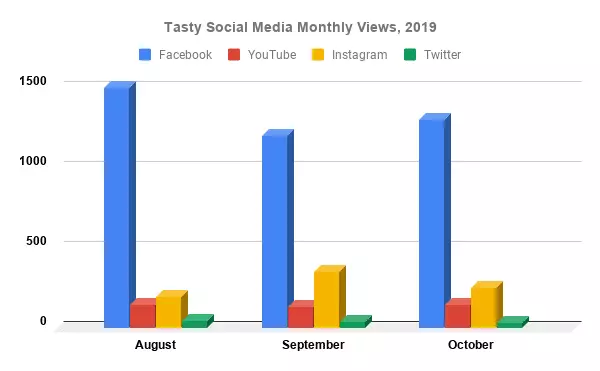
Graph from Tubularlabs.com
Though the niche of the website is different than the parent company, the strategies are the same – create quick videos that deliver extreme value. The food video channel now garners billions of viewers every month and has become a big franchise for the publisher. Surprisingly, more than a hundred people are involved in Tasty (including teams for video production, marketing, ad campaign management, etc).
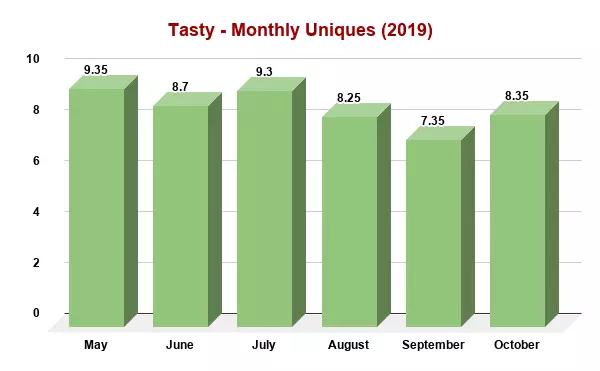
Most importantly, it went from a page to a whole site and Tasty.co attracts 8+ million unique monthly visits, according to SimilarWeb. Interested in learning how Tasty evolved in the last few years? Let’s see the success story of the video recipe website in detail.
Becoming Tasty
Launch and Promotion
2015
Being a publisher, you might have been stuck at the office, with no idea of how to increase traffic and revenue for your outlet. After all, nothing is more disappointing than stumbling upon something that doesn’t yield the desired output. And Jonah Peretti was going through a similar situation as BuzzFeed fell short of its 2015 revenue target by about 32% (Src).
But, the publisher knows a thing or two about what people love to read and watch. And more than that, what content they prefer to share with their friends or family. And when it comes to food, everybody loves it! So, he decided to launch a video channel, BuzzFeed Tasty, tailored-made for Facebook in July 2015.
Initially, Tasty was just a page and was tied to the main website, BuzzFeed. Though it was Peretti who approved the idea of launching Tasty, it was the brainchild of Andrew Gauthier, who became the Chief Video Producer of Tasty.
Tasty had a series of fast and short food recipe videos produced by the BuzzFeed team. The team knew that younger viewers don’t seek out content, but they expect it to be readily accessible to them wherever they are. The fast-paced videos were 30 seconds to 2 minutes long, presented in a lively manner grabbing the attention of the audience.
The Tasty team known as FB40 that operated from New York and Los Angeles, had a camera, lighting equipment and a fully working kitchen where foods and recipes get tested and prepared by the team under the guidance of BuzzFeed Motion Pictures. According to the video publisher, the video creation process takes almost two hours to two weeks for one video (Src). Instead of focusing on background sound, the producer paid close attention to the visuals and utilized the autoplay feature of Facebook to roll videos silently on the social media platform.
“Tasty isn’t Game of Thrones. It’s not this long-form show that feels inaccessible and that you can never recreate.”
-Ashley McCollum, General Manager, Tasty.
Soon after, when the publisher noticed the attraction Tasty was getting, it launched an Instagram page and a video channel on YouTube.
To check how and which recipe videos performed well on YouTube, the publisher produced a 73-second video and posted it to YouTube. And surprisingly, it racked up more than 65,000 viewers in just 22 hours. Then, the publisher shortened the video to 65 seconds and published it to Facebook. In four hours, the video got 8.1M views on Facebook within 22 hours. By looking at the video views, the publisher analyzed how to pass videos to different social media channels at different lengths (Src).
Native Advertising
Since Tasty was launched as a by-product of BuzzFeed that could help the publisher to collect some additional revenue for the publishing company, the video channel itself needed resources to make an online presence. So, instead of getting an investor for the video channel, the publisher started native advertising and plugged in various products or services of sponsors.
The publisher knew that advertisers crave personalized advertising experience and users tend to prefer ads tailored to their behavior and interests. So, the publisher added sponsored posts to its Facebook and the Tasty page that didn’t interrupt the user experience while scrolling the content.
“We want to make content that’s branded and that fits with what’s already on the Web site. The difference from editorial is that we’re working [directly] with brands. We want to make things that people love and engage with.”
-Summerane Burton, Executive Creator Producer
Want to see how Tasty performed in the first two months? According to a report published by Tubular labs, Tasty accounted for 10% of BuzzFeed’s video views (Src) and the Facebook video channel had more than 1.7B views (Src).
Local Facebook Channels
2016
To become the fastest-growing part of the parent company, the publisher explored several approaches and tried everything to resonate with the audience. So, to cater to local culinary food traditions and recipes, Tasty was launched in different foreign versions. As of today, Tasty has six versions including Tasty Miam, Proper Tasty, and Bien Tasty.

As you’ve guessed, the video content adhered to the culturally nuanced food and the folks at Tasty made sure the content was pretty good to cut through the noise and reinforce the brand’s presence.
Video Advertising
2016 was the year when video advertising started getting popular and according to a report published by eMarketer, video ad spending was expected to grow by 20.6% by the end of 2019 (Src). As the publisher continued to add dollars to the brand’s revenue, it was a natural way to dive into video advertising. It was the plan all along.
So, in November 2016, the publisher stated to reach a heap of advertisers who were looking for a platform to advertise their products in the market. Being as an advertiser, Fossil was the first video advertiser of Tasty that promoted watches. Wondering how a Watch advertiser ended with a food channel? According to Fossil, it was the quality of content Tasty had and the way it placed targeted video ads seamlessly inside the player.
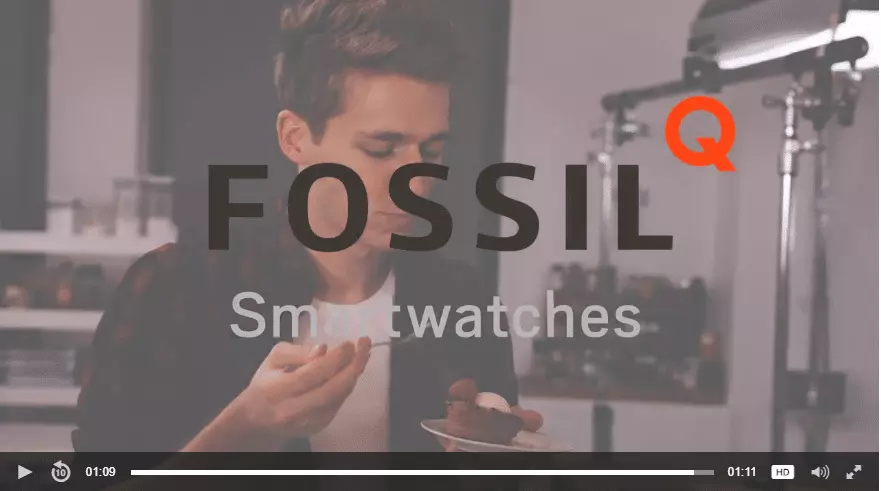
In the digital advertising era, it is essential to provide personalized user experience by targeting the audience and tailoring the right ads that speak to users’ needs and desires. So, the publisher used 98 data points of Facebook to target its followers and some of the most preferred points were location, age, generation, language, gender, users who buy groceries, kind of stores users shops at, type of restaurant users eats at, and many more. This approach helped the publisher to create platform-specific content and targeted ads at the same time.
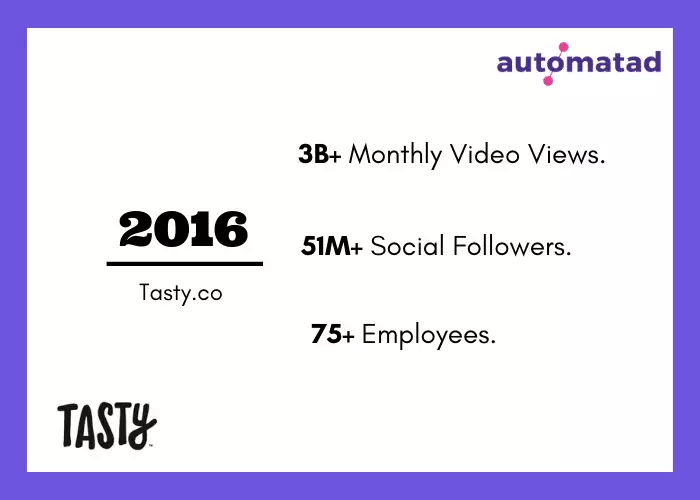
Tasty accounted for 52% of BuzzFeed video views in July 2016 (Src) and witnessed a 30% growth in audience engagement, which was much more than the parent company (Src). With a team of 75 people, Tasty put out 60 videos per month on Facebook alone.
“Tasty definitely showed us there’s a new echelon of performance for video,”
-Michelle Kempner, Head of Social Media.
Publisher Partnerships
Tasty attracted traffic through content marketing on social media platforms and video advertising. In the middle of 2016, the publisher partnered with Today, a well-known purveyor of food recipes, to open a new-source for Tasty to increase its audience base and promote the content by guest blogging. In exchange, Tasty published videos promoting sponsored content of Today on Facebook.
eCommerce Strategy
It was 2016 when eCommerce emerged as a hot topic. So, to bolster the revenue, the publisher launched a new book Tasty Cookbook that was available from $24 to $39. Like all other revenue optimization moves, this was one more method tried by the publisher to capitalize on the trend. Since the launch of the book, around 1,00,000 copies were sold in just two months (Src).
When it comes to selling the cookbook, the publisher sold it through the newly-created eCommerce website, TastyShop. TastyShop was a dedicated place for all foodies, chefs, etc. from where they were able to buy the book online. According to the publisher, the book contributed between $2.4M and $3.9M to the overall revenue.
To do the marketing for the book sale, the publisher took advantage of its audience reach on Facebook and promoted the product through the cover banners on social media page with a custom button “Shop Now” (Src).
After seeing the success of Tasty Cookbook, the publisher started introducing a few more books such as Tasty Latest, Greatest: Everything You Want to Cook Right Now, Tasty Junior Cookbook, etc. In the first week of sales, more than 25,000 copies of the book were sold (Src).
New Website Launch
2017
Until 2017, Tasty was primarily a page and existed within BuzzFeed. And the traffic coming through social media contributed to the parent company. But, in 2017, the producer realized that they could launch a new dedicated website without the halo of the main brand, BuzzFeed. And, it worked well. We’ll get to the numbers later. Let’s focus on the next launch.
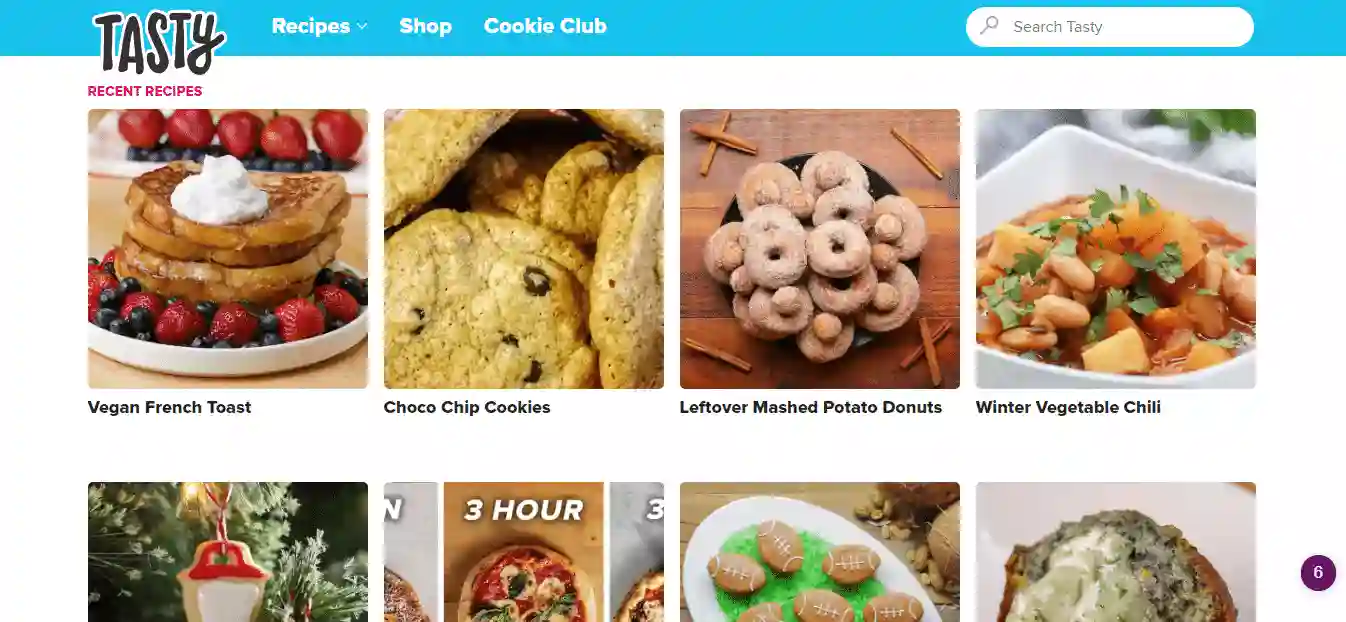
Tasty App Launch
In the second quarter of 2017, the publisher developed a separate app Tasty for its iPhone users. Now the mobile app users had access to over 3,000 recipes, all existing in one place. The videos were available on the app even before getting released on social media platforms.
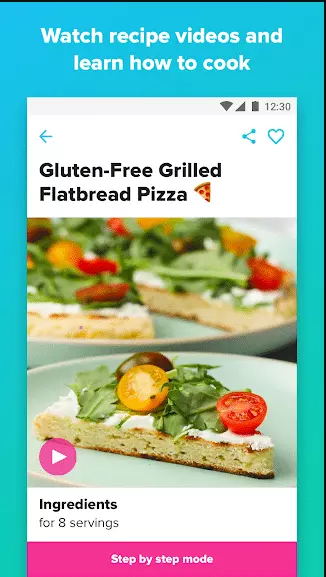
Users were able to search and read the recipes by using its Step-by-step mode that segregated the video to multiple steps and also export the ingredient list via emails or other messaging apps. In a year, the application was downloaded by more than 9M people (Src).
Wondering what drove the users to download the app? Apparently, the value it provides. Users were used to Tasty’s video content and they know what it delivers. In fact, Tasty developed and marketed its app after testing what will entice the audience to download the app. In other words, there’s no friction.
And, the publisher realized it’s not better to rely on Facebook. We’ve always suggested the publishers stay independent and use the platforms wisely. With algorithmic changes and a deeper revenue cut, it’s best to attract users into your properties.
Tasty Smart Device
After a few days of the launch of the app, the publisher introduced a new smart product called “Tasty One Top”, an Induction Cooktop that could be operated through Bluetooth. Designed by the BuzzFeed Product Labs and with the help of GE Appliance’s First Build Team, the product ensured the perfect execution of every recipe.
The smart device was promoted through the Tasty app and sold through the TastyShop. Indeed, the cooktop that was available at $149 in the US helped the publisher to get an additional revenue source. If you look at it, it’s not surprising at all.
Tasty started with videos on social media platforms and established an eCommerce wing to sell its book. If it can sell cookbooks, then why not other kitchen utensils.
Sponsored Facebook Videos
We’ve already hinted it before in this post. Tasty used Facebook to not just build its brand and direct traffic, but also to run sponsored videos. Tasty leveraged its massive platform reach (it has closed to 100M followers on Facebook alone) to help other brands to tell their stories different.
“A lot of brands want us to help their audience see the product differently, or a transformative use of the product”
– Ashley McCollum, General Manager, Tasty.
From Baileys to Oster, the publisher partnered with several niche brands, right from the start. Did BuzzFeed brand association help them to ink deals? Yes. But more than that, the quality of videos, engagement rates, and audience reach did the trick. And, even in the open web, publishers with quality content, engaged audience, and reach can replicate the same.
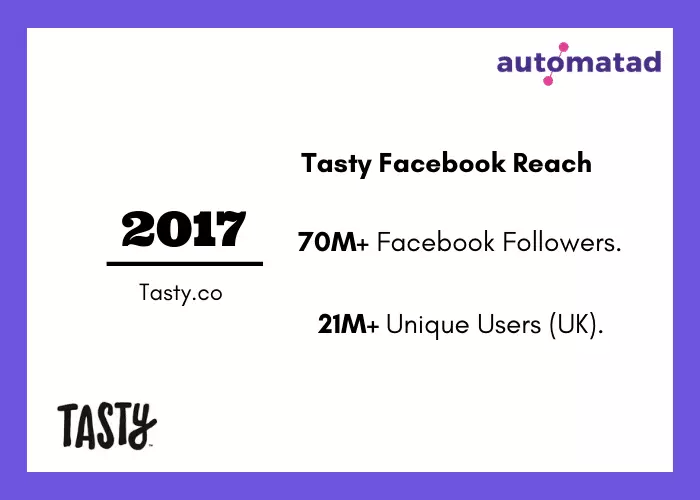
Spin-Offs
The publisher never failed to look at the analytics and the decisions were backed with reliable data. So, in 2018, the publisher spun off the website and introduced four new segments – Tasty Junior, Tasty One-Pot, Tasty Happy Hour, and Tasty Vegetarian.
Each of the segments focusing on their category exclusively. Although the new segments were added to the BuzzFeed, it helped the publisher to create a better picture of how content on each segment is performing and how to cater to different markets. Reaching more than a hundred million people on a platform means you need to strategize and segment to scale.
Commerce with Walmart
2018
The publisher was no stranger to the rollercoaster ride of ad-independent and dependent revenue. However, eCommerce strategy has been playing a vital role in driving revenue.
So, back in March 2018, Tasty partnered with Walmart to sell its newly-launched Cookware sets at $99 (Src). The eCommerce strategy was adopted by the publisher to overcome the missed revenue target of the previous year, as said by Jonah Peretti.
In the months that followed, the publisher introduced more than 90 items. The actual manufacturing of products was done by Epoca International Inc. The goods were shipped to the BuzzFeed division. From there, a Commerce team of 65 people started selling the products in a matter of days by creating buzz on social media. Not only cooking utensils, but the company also started to provide meal-kits such as pot roast and chicken parmesan, and the price range varied from $8 to $15 (Src).

The marketing team of Tasty was well aware of the omnipresent behavior of Facebook. So, to grow the partnership with Walmart, it used one of the data points of Facebook and targeted the users residing within 10 miles of the Walmart Store. The publisher used targeting for selling its products as well.
They also tracked users checking the ingredients to figure out what kind of recipes they are interested in, and then targeted them with the relevant content ad on the website and other social media platforms. Want to know how this partnership helped the publisher? As disclosed by one of their team members, more than 4M units of Tasty cookware got sold in just a few months.
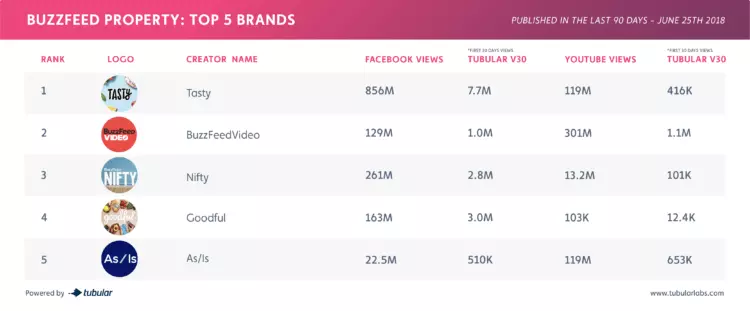
Programmatic Approach
It was 2018. And programmatic advertising has been around long enough. So, to increase the online ad revenue of Tasty, the publisher pumped up its efforts on programmatic methods and harnessed various technologies to maximize ad revenue.
In the world of digital advertising, display or banner ads are the hero. So, the publisher began testing banner ads and started selling the remnant ad inventories to the advertisers. A glance of how Tasty does display advertising:
The website display banner ads at the top of the page through Exchange Bidding on Google’s ad server. The publisher integrated multiple demand partners to Ad Manager and sold the inventories at maximum possible CPM rates.
The display ads were rendered inside Google SafeFrame to ensure the ad creatives aren’t interfering with the site content. The SafeFrame container provided by Google Ad Manager ensures publishers that the ad server will not affect the ads tags/codes present on the website.
However, as you might know, Google takes a revenue share from publishers who have enabled Exchange Bidding on their website. So, the advertising team of Tasty thought to give a try to Header Bidding, an equivalent of Google’s Exchange Bidding that doesn’t demand a deeper revenue cut in return. So, let’s understand how the publishers serve ads through Header Bidding.
Header Bidding is a technique that connects several demand partners to the publishers’ inventory and considers bids from multiple groups of buyers at once. Hence, Tasty partnered with a variety of demand partners including Rubicon, AppNexus, OpenX, and Index Exchange.
The publisher integrated all the yield partners to the website through a wrapper to increase the programmatic yield of the site. Not only the major ad exchanges and supply-side platforms, but the website is also integrated with the Database Management Platform, Permutive to place better-targeted ads and handle the third-party cookie blocking issues.
As said by the publisher, Header Bidding helped them to recognize the huge untapped potential of programmatic advertising while ensuring transparency.
Interestingly, the publisher only runs larger ad unit sizes (300*600, 720*90) for its desktop traffic. There are 3 to 4 lazy loading ads and the publisher isn’t running any smaller ad units. As we know, larger ad units tend to capture attention, have better viewability and CTR.
On the contrary, mobile traffic only has 300*250 ad units (6 to 7) lazy-loaded as soon as the users scroll them into the viewport.
Conclusion
Tasty is just a four years site. And by several measures, it has produced some of the most popular videos in the world. Recently, the publisher has launched a customizable book for visitors. Now, the readers can add or remove recipes by their choice and get it printed. Tasty has witnessed massively scaled-up content and revenue and evolved as a media behemoth. A big difference between Tasty and other publishers is that Tasty never aggregates anyone else’s content and everything published on the site is made in-house. The important takeaway is how the publisher experimented with different formats, content, and platforms and shifted from others to its properties.























